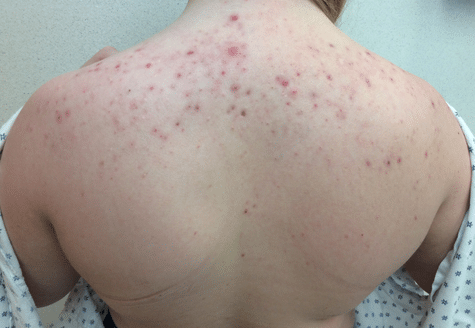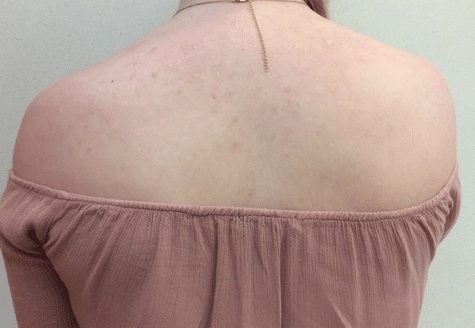Back acne, commonly known as “bacne,” affects millions of people and can be just as frustrating as facial breakouts. While it may seem stubborn and challenging to treat, board-certified dermatologists Dr. Joel Schlessinger and Dr. Daniel Schlessinger have developed proven strategies to help achieve clearer, healthier skin on your back. With the right approach and consistency, back and shoulder acne is absolutely treatable.
Why back acne develops
Understanding different types of back acne
Recommended treatment approach
Addressing back acne scars
Final thoughts
Why back acne develops
The skin on your back is uniquely problematic when it comes to acne. It’s thicker than facial skin and contains numerous large sebaceous glands that produce sebum, a type of oil.
“Several factors contribute to back acne development,” explains Dr. Joel Schlessinger. “Hormonal fluctuations, including testosterone or creatine supplementation, affect sebaceous gland activity, while genetics determine your skin’s predisposition to acne. Environmental factors like excessive sweating and friction from clothing or sports equipment create the perfect conditions for breakouts to develop. Lastly, infections can arise when working out or touching mats or other equipment during yoga or floor-based exercises.”
Understanding different types of back acne
Not all back acne is the same, and this distinction is crucial for determining the proper treatment approach. Dr. Daniel Schlessinger notes: “In practice, I see patients with various forms of back acne, each requiring a tailored approach. Comedonal acne presents as those familiar blackheads and whiteheads, while inflammatory acne includes the red, tender papules and pustules that patients find most bothersome. The more severe cases develop nodular or cystic acne, which penetrates much deeper into the skin and often leads to permanent scarring if left untreated.”
The cases that concern dermatologists most are nodular and cystic acne lesions. These penetrate deep into the skin and almost always lead to permanent scarring if left untreated. Early intervention is crucial for these deeper lesions.
Sometimes, what patients think is acne is actually something entirely different. Dr. Joel Schlessinger notes that he has diagnosed everything from bacterial infections to hidradenitis suppurativa in patients who came in thinking they had severe back acne. This is why professional evaluation is so important when over-the-counter treatments aren’t working.
Recommended treatment approach
Starting with over-the-counter solutions
For mild to moderate back acne, dermatologists recommend starting with proven over-the-counter ingredients. Salicylic acid is excellent for unclogging pores and reducing inflammation, making it a top recommendation for comedonal acne.
“I always tell patients to start with a body wash from CLn, which contains Sodium Hypochlorite, a diluted component in bleach,” advises Dr. Daniel Schlessinger. “The key is proper application technique. Apply the cleanser to affected areas and let it sit for 3-5 minutes to allow the active ingredients to penetrate. Then, rinse thoroughly. Consistency is crucial for achieving results.”
Glycolic acid and lactic acid can also help exfoliate dead skin cells and prevent future breakouts. However, dermatologists caution patients about over-exfoliation, which can actually worsen acne by causing irritation.
When to consider professional treatment
Clinical experience has shown that timing is everything with back acne treatment. Dr. Daniel Schlessinger has a clear guideline for his patients: “My general rule is this: If you’ve been consistent with an over-the-counter routine for several weeks without seeing any improvement, it’s time to come in. What looks like acne could actually be a bacterial infection, such as Staph or pseudomonas folliculitis, which requires different treatment. It could also be yeast (pityrosporum) folliculitis, which also requires an oral treatment.”
Back Acne Treated at Schlessinger MD
Even for moderate to severe cases of acne, dermatologists often prescribe topical retinoids, which work by accelerating cellular turnover and preventing the formation of microcomedones, which are the precursors to all acne lesions. Oral medications like antibiotics or isotretinoin (Accutane) may be necessary for stubborn cases.
Addressing back acne scars
“When it comes to scaring, the importance of early intervention can’t be dismissed,” says Dr. Joel Schlessinger. “Once scars have formed, we can address them with certain treatment options, but completely getting rid of bacne scars completely is very difficult, if not impossible. Prevention is always preferable, which is why an early visit to your dermatologist is so important. Dermatologists have access to tools such as Accutane, a powerful derivative of vitamin A, that has been clinically proven to reduce or even put acne into remission. I frequently use it on my most challenging back acne patients. Lastly, I often see patients who have been misdiagnosed as having back acne, but instead have a condition called hidradenitis suppurativa, which is treatable with a variety of newer medications that are not commonly used for acne.”
For existing scars, several professional treatments are available. Professional treatments also include chemical peels and Diamond Glow microdermabrasion. These treatments utilize higher concentrations of active ingredients than what’s available over-the-counter and can penetrate deeper into the skin.
Due to the extended area of the back, these treatments can be expensive, so dermatologists always discuss realistic expectations and treatment timelines with patients.
The path forward
Successfully treating back acne requires patience, consistency and often a combination of approaches. Whether you’re dealing with occasional breakouts or persistent cystic acne, effective treatments exist for every severity level.
Most treatments require at least six to twelve weeks to show significant improvement. Dermatologists always remind patients that skin care is a marathon, not a sprint. Stay committed to your treatment plan, make necessary lifestyle adjustments, and celebrate small improvements along the way.
If your back acne is affecting your confidence or quality of life, don’t hesitate to seek professional help.
Ready to discover what your skin can look like with expert care? Contact Schlessinger MD to book a dermatology appointment today.


